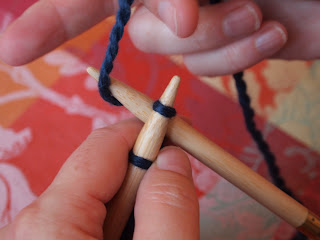So I work it a little differently - with this method I can bind off a row in about the same time as it takes to knit one.
1. Knit the first 2 stitches together (generally through the back loop works best) - now you are ready to start binding off.
2. Slip the next stitch (knitswise or purlwise) onto the right needle. You can use either method, but you'll get different results, so use one for the whole row. Test them both and find out which works best for you and for your particular project.
slipping purlwise
slipping knitwise
3. Now, insert the left needle from left to right through the front loops on the on the right needle. Once the needle is in this position you are ready to knit 2 together (k2tog) the usual way.
inserting the needle from left to right
4. With the needles in this position, k2tog the usual way.
knitting 2 together (k2tog)
finishing the k2tog - the stitch will then be on the right needle
5. Repeat from step 2 until you have finished the whole row.
I find this movement is much more like the regular flow of knitting and the best thing is there is no lifting of the stitches.
It's not super-stretchy but I find it generally has enough give for lace that is to be blocked and gives a nice cabled edge.
If you need extra stretchy bind-off, knit the stitch instead of slipping it in step 2.
If you have to bind off on the ws, you can get the same effect by working p2tog (purl 2 together) instead of k2tog.
One more tip - don't break your yarn until after blocking. That way if you have to redo anything at least you won't have to join yarn as well.











